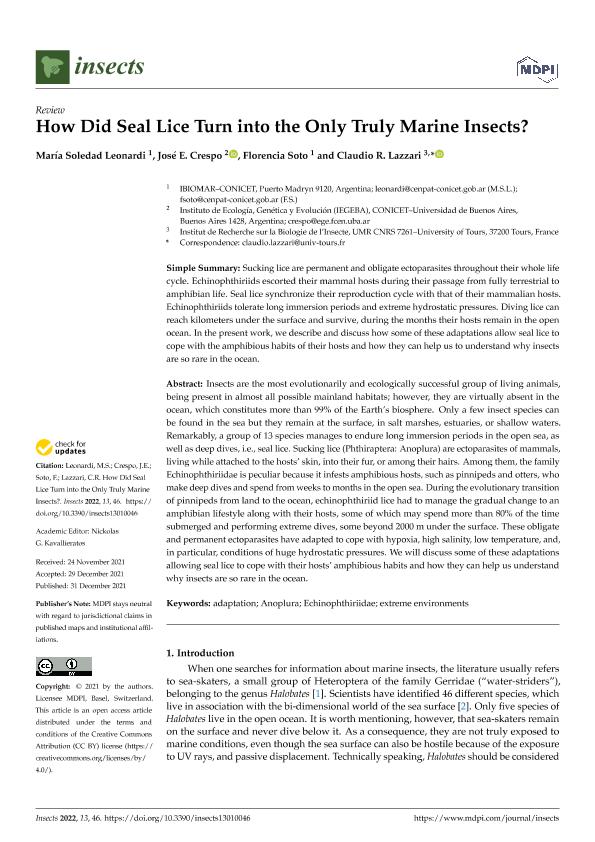Artículo
How Did Seal Lice Turn into the Only Truly Marine Insects?
Fecha de publicación:
12/2021
Editorial:
MDPI AG
Revista:
Insects
ISSN:
2075-4450
Idioma:
Inglés
Tipo de recurso:
Artículo publicado
Clasificación temática:
Resumen
Insects are the most evolutionarily and ecologically successful group of living animals, being present in almost all possible mainland habitats; however, they are virtually absent in the ocean, which constitutes more than 99% of the Earth’s biosphere. Only a few insect species can be found in the sea but they remain at the surface, in salt marshes, estuaries, or shallow waters. Remarkably, a group of 13 species manages to endure long immersion periods in the open sea, as well as deep dives, i.e., seal lice. Sucking lice (Phthiraptera: Anoplura) are ectoparasites of mammals, living while attached to the hosts’ skin, into their fur, or among their hairs. Among them, the family Echinophthiriidae is peculiar because it infests amphibious hosts, such as pinnipeds and otters, who make deep dives and spend from weeks to months in the open sea. During the evolutionary transition of pinnipeds from land to the ocean, echinophthiriid lice had to manage the gradual change to an amphibian lifestyle along with their hosts, some of which may spend more than 80% of the time submerged and performing extreme dives, some beyond 2000 m under the surface. These obligate and permanent ectoparasites have adapted to cope with hypoxia, high salinity, low temperature, and, in particular, conditions of huge hydrostatic pressures. We will discuss some of these adaptations allowing seal lice to cope with their hosts’ amphibious habits and how they can help us understand why insects are so rare in the ocean.
Palabras clave:
ADAPTATION
,
ANOPLURA
,
ECHINOPHTHIRIIDAE
,
EXTREME ENVIRONMENTS
Archivos asociados
Licencia
Identificadores
Colecciones
Articulos(IBIOMAR)
Articulos de INSTITUTO DE BIOLOGIA DE ORGANISMOS MARINOS
Articulos de INSTITUTO DE BIOLOGIA DE ORGANISMOS MARINOS
Articulos(IEGEBA)
Articulos de INSTITUTO DE ECOLOGIA, GENETICA Y EVOLUCION DE BS. AS
Articulos de INSTITUTO DE ECOLOGIA, GENETICA Y EVOLUCION DE BS. AS
Articulos(OCA CIUDAD UNIVERSITARIA)
Articulos de OFICINA DE COORDINACION ADMINISTRATIVA CIUDAD UNIVERSITARIA
Articulos de OFICINA DE COORDINACION ADMINISTRATIVA CIUDAD UNIVERSITARIA
Citación
Leonardi, María Soledad; Crespo, José Emilio; Soto, Florencia Anabella; Lazzari, Claudio R.; How Did Seal Lice Turn into the Only Truly Marine Insects?; MDPI AG; Insects; 13; 1; 12-2021; 1-9
Compartir
Altmétricas




